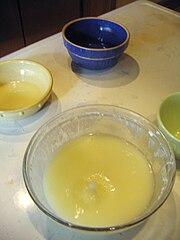Whey

Whey collecting as newly made cheese drains
|
|
| Nutritional value per 100 g (3.5 oz) | |
|---|---|
| Energy | 112 kJ (27 kcal) |
|
5.14 g
|
|
| Sugars | 5.14 g |
|
0.36 g
|
|
|
0.85 g
|
|
| Minerals | |
| Calcium |
(5%)
47 mg |
| Other constituents | |
| Water | 93.12 g |
|
|
| Percentages are roughly approximated using US recommendations for adults. Source: USDA Nutrient Database |
|
Whey is the liquid remaining after milk has been curdled and strained. It is a of the manufacture of cheese or casein and has several commercial uses. Sweet whey is manufactured during the making of rennet types of hard cheese like Cheddar or Swiss cheese. Acid whey (also known as "sour whey") is a byproduct produced during the making of acid types of dairy products such as cottage cheese or strained yogurt.
Whey proteins consist of α-lactalbumin, β-lactoglobulin, serum albumin, immunoglobulins, and proteose-peptones.
To produce cheese, rennet or an edible acid is added to heated milk. This makes the milk coagulate or curdle, separating the milk solids (curds) from the liquid whey. Sweet whey is the byproduct of rennet-coagulated cheese, and acid whey (also called sour whey) is the byproduct of acid-coagulated cheese. Sweet whey has a pH greater than or equal to 5.6, acid whey has a pH less than or equal to 5.1.
Whey is used to produce whey cheeses such as ricotta, whey butter, so-called brunost (brown cheeses—technically not cheeses at all), and many other products for human consumption. The fat content of whey is low; for example 1,000 kg of whey are required to make typically 1 kg of whey butter. It is also an additive in many processed foods, including breads, crackers, and commercial pastry, and in animal feed. Whey proteins consist primarily of α-lactalbumin and β-lactoglobulin. Depending on the method of manufacture, whey may also contain glycomacropeptides (GMP).
...
Wikipedia
